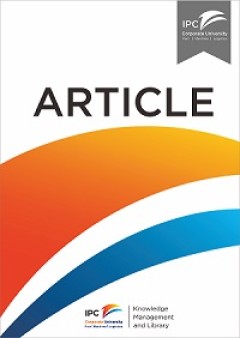Ditapis dengan

Enhancing customer orientation of service delivery systems: an integrative fr…
To streamline and improve their service delivery systems, service organizations have much to learn from their manufacturing counterparts in the use of quality and process improvement tools. The purpose of this article is to present a practical framework which integrates these tools in order to enhance the efficiency and customer orientation of service delivery systems. Two examples are used to …
- Edisi
- Volume 9 · Number 3 · 1999 · pp. 198–203
- ISBN/ISSN
- 0960-4529
- Deskripsi Fisik
- 8 p.
- Judul Seri
- Managing Service Quality: An International Journal
- No. Panggil
- ATC LE MAH e C.1

Disentangling customer orientation – executiveperspective
Despite the fact that customer orientation is increasingly used as a strategic guideline to ensure companies’ long-term success, it is too often left at conceptual level without any managerial or executive translation. To address this practical gap, the purpose of the paper is to build an executive perspective on customer orientation through the mechanism of customer value dimensions.
- Edisi
- Vol. 20 No. 5, 2014 pp. 663-677
- ISBN/ISSN
- 1463-7154
- Deskripsi Fisik
- 17 p.
- Judul Seri
- Business Process Management Journal
- No. Panggil
- ATC MG SAA d

Effects of organizational and serviceperson orientation on customer loyalty
Within the service industry, the serviceperson enhances customer loyalty by increasing customer benefits and decreasing customer costs, but is also embedded within and influenced by the organizational context. Thus, the influence of a serviceperson’s orientation may differ or even conflict with the organization’s orientation. There are two purposes to this paper. The paper first aims t…
- Edisi
- Vol. 47 No. 10, 2009 pp. 1489-1513
- ISBN/ISSN
- 0025-1747
- Deskripsi Fisik
- 27 p.
- Judul Seri
- Management Decision
- No. Panggil
- ATC MG COL e

Customer orientation of service employees : its impact on customer satisfacti…
With the performance of service personnel often constituting a major element of a service per se, the customer orientation of service personnel is often regarded as a main determinant of service firms’ success. Drawing on a deductively derived four-dimensional conceptualization of the customer orientation of service personnel, consisting of employees’ technical skills, social skills, motiv…
- Edisi
- Vol. 15 Iss 5 pp. 460 - 478
- ISBN/ISSN
- -
- Deskripsi Fisik
- 27 p.
- Judul Seri
- International Journal of Service Industry Management
- No. Panggil
- ATC LE THU c

Explaining why employee-customer orientation influences customers’ percept…
The purpose of this paper is to examine why employee-level customer orientation (CO) influences the customer experience in a service setting.
- Edisi
- Vol. 24 No. 4, 2013 pp. 382-400
- ISBN/ISSN
- 1757-5818
- Deskripsi Fisik
- 21 p.
- Judul Seri
- Journal of Service Management
- No. Panggil
- ATC MG GAZ e

An empirical analysis of the components of retailer customer loyalty programs
This paper sets out to determine the benefits offered to customers and activities taken by retailers, whether or not they have formal customer loyalty programs, whether there are differences in the benefits/activities of retailers with and without formal loyalty programs and finally, whether specific benefits/activities of retailers can predict whether or not they have formal loyalty programs.
- Edisi
- Vol. 36 No. 1, 2008 pp. 32-49
- ISBN/ISSN
- -
- Deskripsi Fisik
- 21 p .
- Judul Seri
- International Journal of Retail & Distribution Management
- No. Panggil
- ATC LO TOP a
 Karya Umum
Karya Umum  Filsafat
Filsafat  Agama
Agama  Ilmu-ilmu Sosial
Ilmu-ilmu Sosial  Bahasa
Bahasa  Ilmu-ilmu Murni
Ilmu-ilmu Murni  Ilmu-ilmu Terapan
Ilmu-ilmu Terapan  Kesenian, Hiburan, dan Olahraga
Kesenian, Hiburan, dan Olahraga  Kesusastraan
Kesusastraan  Geografi dan Sejarah
Geografi dan Sejarah